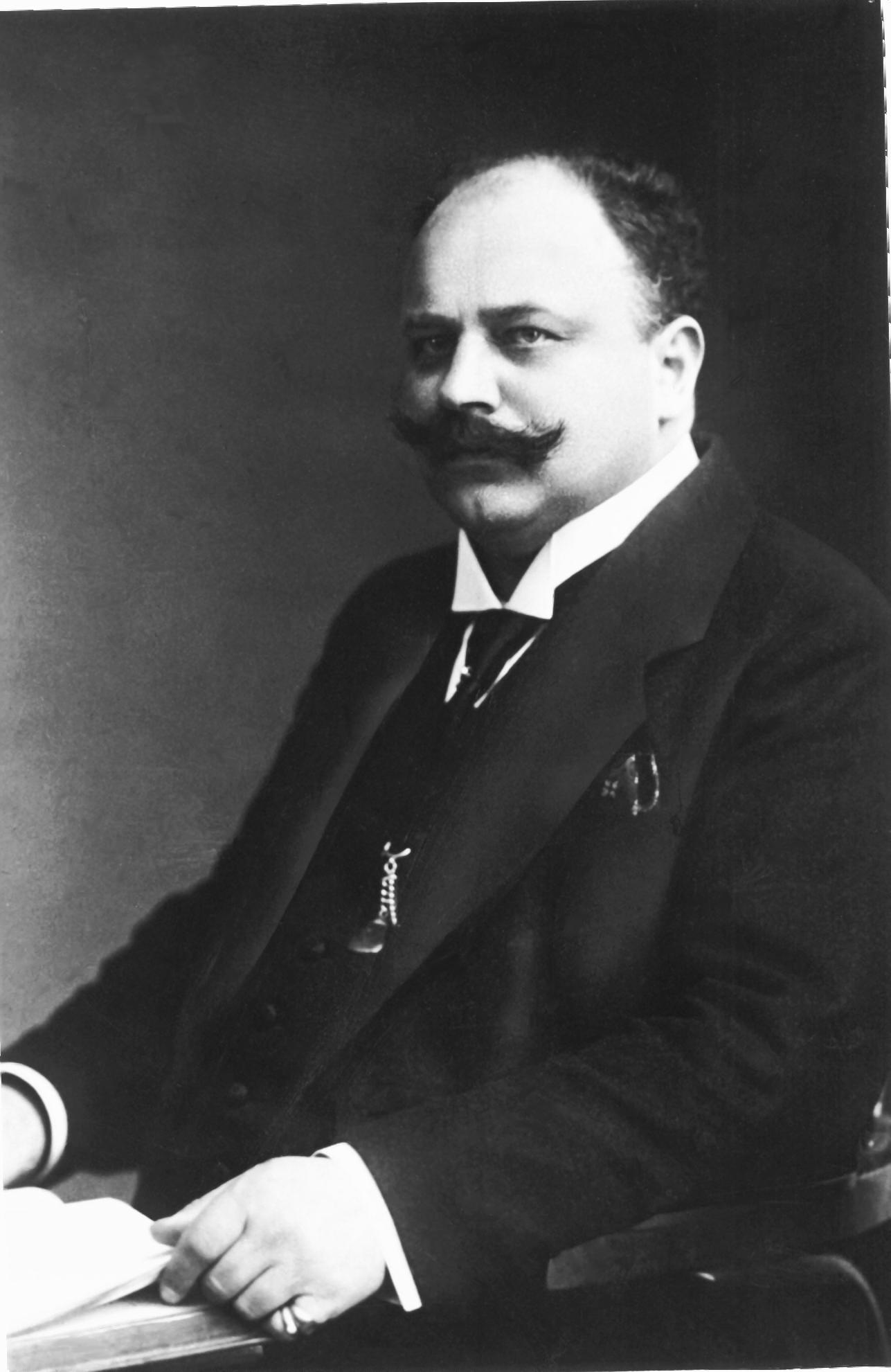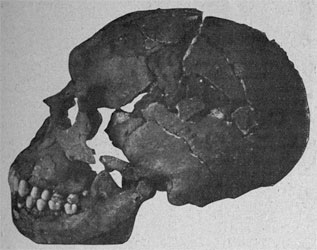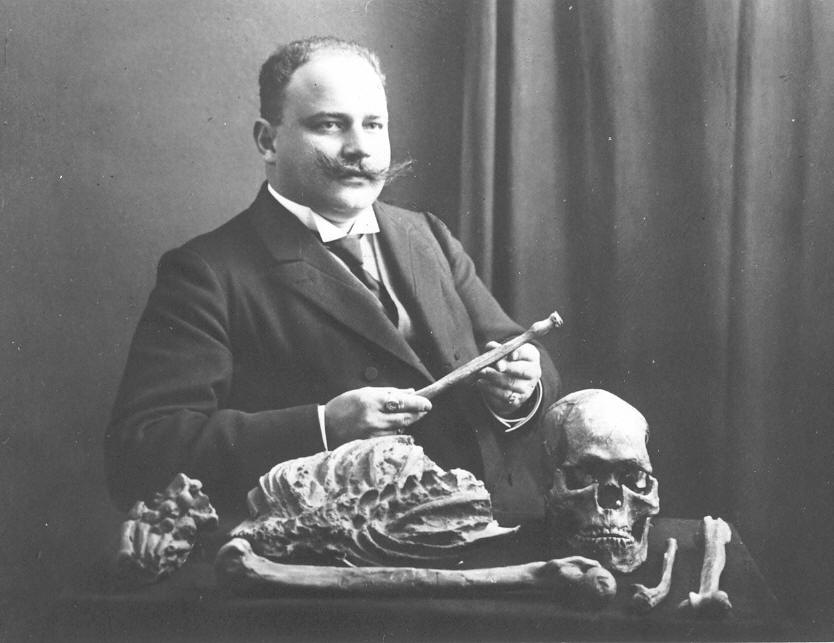Otto Hauser (1874–1932)
Matthew Goodrum

Otto Hauser was born 12 April 1874 in Wädenswil, Switzerland, to parents who ran a hotel. He studied classical philology, history, and archeology at the University of Basel from 1892 to 1894. From 1894 to 1900, he continued his studies in the Philosophical Faculty of the University of Zurich and at the Eidgenössischen Technischen Hochschule Zürich [Federal Institute of Technology Zurich]. Hauser was soon able to pursue his interest in archaeology when he excavated the Roman camp of Vindonissa, located in Windisch in northern Switzerland, during 1897 and 1898 where he discovered the remains of an amphitheater. Remarkable prehistoric discoveries were being made throughout Europe and this prompted Hauser to travel to the Vézère valley in the Dordogne region of France in 1898 where he began to explore sites previously excavated by French paleontologist Edouard Lartet and his English collaborator Henry Christy. In 1904 Hauser opened an antiquities shop in Munich, Germany, and began selling Paleolithic artifacts to fund his excavations.
As a result of the success of these early endeavors, Hauser bought a house near Laugerie-Haute in 1906 and rented land at twenty Paleolithic sites in the Vézère valley. He began excavating the Paleolithic site of La Micoque in 1906 with French archaeologist Louis Capitan (the two first met in 1895). Hauser continued working at the site on his own until 1914, and during that time, he unearthed stone artifacts that he believed represented a distinct Micoquian culture and race, which he thought were related to fossil human bones found at Taubach and Ehringsdorf in Germany. European archaeologists generally accepted some modified version of French archaeologist Gabriel de Mortillet’s identification of a succession of Paleolithic stone tool industries (Chellean, Mousterian, Solutrean, Magdalenian), so Hauser’s proposal of a new Micoquian industry marked a potentially important but controversial idea. Hauser described the results of his excavations and outlined his ideas about Micoquian artifacts in Die neuesten Ausgrabungen auf La Micoque (Dordogne) und ihre Resultate für die Kenntnis der paläolithischen Kultur [Recent Excavations at La Micoque (Dordogne) and Their Results for the Knowledge of Paleolithic Culture] published in 1907. He later expanded upon these ideas in La Micoque: die Kultur einer neuen Diluvialrasse [La Micoque: The Culture of a New Ice Age Race] (1916). Hauser’s identification of a unique Micoquian culture created complications for the new classification of Paleolithic artifacts and schemes for Paleolithic chronology being proposed by French prehistorian Henri Breuil but it gained the support of Berlin geologist Emil Werth and was eventually adopted, with modifications, by Breuil. It is important to note, given subsequent events, that Hauser sold a large number of Micoquean artifacts in 1906 to the Naturhistorischen Gesellschaft Nürnberg [Nuremberg Natural History Society] and other museums in Germany in order to help fund his ongoing excavations
Hauser began working other Paleolithic sites as well. He undertook excavations of the rock shelters at Le Moustier in September 1907 and soon found Acheulean flint implements. French archaeologists had explored the Paleolithic deposits at Le Moustier since the 1860s, and artifacts found at the site formed the basis for Gabriel de Mortillet’s Mousterian industry. However, on 7 March 1908, Hauser’s workmen unearthed fossilized human bones at the site. The discovery of a nearly complete human skeleton from the Pleistocene was a rare event of potentially great scientific importance, so Hauser invited a group of prominent German scientists that included anthropologist Hermann Klaatsch, anatomist Hans Virchow, and archaeologist Gustaf Kossina to observe the skeleton in situ, and on 18 April, they witnessed the excavation of the precious specimen. The body appeared to have been intentionally buried, and there were stone tools found with it. Hauser did not possess the anatomical or anthropological knowledge needed to examine the skeleton, so he invited Hermann Klaatsch, professor of anatomy and anthropology at the University of Breslau (now Wrocław, in Poland), to study the specimen. Klaatsch was familiar with the Neanderthal (or Homo primigenius as they were often called at this time) fossils that the Croatian paleontologist Dragutin Gorjanović-Kramberger discovered at Krapina at the turn of the century, as well as with the Homo heidelbergensis [Heidelberg man] fossils found in Germany in 1906. The Moustier skeleton resembled Neanderthal specimens found throughout Europe and despite the fact that Klaatsch believed it belonged to the “Neanderthal type” he decided to assign the specimen to a new species of hominid he called Homo mousteriensis Hauseri (Klaatsch and Hauser 1909; Klaatsch 1909).

This remarkable discovery was soon followed by another. Hauser began excavating the Paleolithic site of Combe-Capelle in 1907. The site contained artifacts ranging from the Mousterian, Aurignacian, and Solutrean. On 26 August 1909, Hauser discovered a human skeleton associated with remains of a shell necklace and Aurignacian tools. Hauser did not immediately remove the skeleton but waited until Hermann Klaatsch could join him, and on 12 September, they excavated the nearly complete skeleton. From its stratigraphic position and the artifacts found with it they concluded the specimen represented an early human from the Aurignacian period (Hauser and Klaatsch 1908). However, due to the poor excavation methods Hauser employed, researchers have doubts regarding the geologic age of this specimen. Klaatsch studied the bones and concluded they differed from both the Neanderthals and the Cro-Magnons and therefore represented a new race that he named Homo aurignacensis hauseri. Klaatsch argued that this Aurignacian race had arrived in Europe from Asia and had preceded the arrival of Cro-Magnon Man (Klaatsch and Hauser 1910). While excavating the Paleolithic site of La Rochette in 1910 Hauser unearthed yet another partial human skeleton, associated with pierced horse teeth, that he attributed to the Aurignacian period. Hermann Klaatsch and Walter Lustig published a description of the fossils in 1914 (Klaatsch and Lustig 1914).

Hauser’s excavations and his sale of artifacts abroad angered some French archaeologists. The marquis de Fayolle, president of the Société Historique et Archéologique du Périgord, began to oppose Hauser’s plundering of artifacts in 1907, and the French newspaper Le Matin published an article in 1910 denouncing Hauser’s sale of prehistoric artifacts abroad, suggesting he was motivated more by profit than by science. French scientists were incensed when Hauser sold both the Moustier and Combe-Capelle skeletons to the Museum für Völkerkunde in Berlin after asking an exorbitant sum for the specimens.1 A group of French archaeologists, including Louis Capitan, Henri Breuil, and Denis Peyrony responded by asking government officials to intervene. This led the French government to pass a law in 1913 protecting antiquities and banning their export. Since Hauser largely funded his research by the sale of artifacts this created significant financial difficulties for him. Hauser was eventually driven from France in August 1914 with the beginning of World War I. The French government confiscated his house and storage facilities and Denis Peyrony, a local archaeologist who was also conducting excavations in the Vézère valley, took over the excavations of his sites.
Hauser went to Germany after being driven from France. He received a doctorate from the University of Erlangen in 1916 for a dissertation titled Über eine neue Chronologie des mittleren Paläolithikums im Vézèretal [A New Chronology of the Middle Paleolithic in the Vézère Valley] outlining his ideas about Middle Paleolithic archaeological cultures, including his ideas about a Micoquian industry, based upon his excavations. Hauser spent the rest of his life in Germany, living in Weimar from 1925 to 1929 and then in Berlin until his death. He earned a living by lecturing and writing books on prehistory. Among his most popular books was Der Mensch vor 100000 Jahren [Man 100,000 Years Ago]. Hauser died 14 June 1932 in Berlin.
Selected Bibliography
Die neuesten Ausgrabungen auf La Micoque (Dordogne) und ihre Resultate für die Kenntnis der paläolithischen Kultur. Basel: Selbstverl, 1907.
“Fouilles scientifiques à la Micoque, à Laugerie-Basse et au Moustier.” L’Homme préhistorique (1908): 40-48.
Otto Hauser and Hermann Klaatsch. “Der neue Skelettfund Hausers aus dem Aurignacien.” Praehistorische Zeitschrift 2 (1908): 180-182.
“Découverte d’un squelette du type de Néandertal sous l’abri inférieur du Moustier.” L’Homme préhistorique (1909): 1-16.
Hermann Klaatsch and Otto Hauser, “Homo mousteriensis Hauseri: ein altdiluvialer Skelettfund im Departement Dordogne, und seine zugehorigkeit zum Neandertaltypus.” (Archiv für Anthropologie 7 (1909): 287-297.
Hermann Klaatsch, “Preuves que l’Homo mousteriensis Hauseri appartient au type du Néandertal.” L’Homme prehistorique (1909): 10-16.
Hermann Klaatsch and Otto Hauser, “Homo aurienacensis Hauseri, ein palæolithischen Skelettfund aus dem unteren Aurignacien der Station Combe-Capelle bei Montferrand (Périgord).” Praehistorische Zcitschrift 1 (1910): 273–338.
Le Périgord préhistorique: guide pour les excursions dans les vallées de la Vézère et de la Dordogne et pour l’étude de leurs stations préhistoriques. Le Bugue: G. Réjou, 1911.
Hermann Klaatsch and Walter Lustig, “Morphologie der paläolithischen Skelettreste des mittleren Aurignacien der Grotte von La Rochette, Dep. Dordogne.” Archiv für Anthropologie 41 (1914): 81-126.
La Micoque: die Kultur einer neuen Diluvialrasse. Leipzig: Veit, 1916.
Uber eine neue chronologie des mittleren paläolithilums im Vézèretal.
Speziell mit bezug auf la Micoque. Leipzig, Veit & comp., 1916.
Ins Paradies des Urmenschen, fünfundzwanzig Jahre Vorweltforschung. Hamburg: Hoffmann und Campe, 1920.
Urmensch und Wilder: eine Parallele aus Urwelttagen und Gegenwart. Berlin: Ullstein, 1921.
Der Mensch vor 100000 Jahren. Jena: Thüringer Verlagsanst, 1924.
Die grosse zentraleuropäische Urrasse; la Micoque, Ehringsdorf, Byci skála, Predmost, Kisla Nedzimova. Langensalza: Beltz, 1925.
Urgeschichte: aus Grundlage praktischer Ausgrabungen und Forschungen. Jena: Thüringer Verlagsanstalt und Druckerei, 1925.
Urwelt. Berlin: Büchergilde Gutenberg, 1929.
Secondary Sources
Karl Brandt, Otto Hauser, die Tragik eines Urgeschichtsforschers: Im Paradies d. Urmenschen. Bonn: Mannus-Verl. 1970.
J.-M. Bouvier, “Le Poisson, Otto Hauser et les autres.” Bulletin de la Société d’Etudes et de Recherches Préhistoriques des Eyzies (1978): 55-58.
Jean-Jacques Cleyet-Merle, “Otto Hauser.” Paléo 1 (1990): 72-75.
Brigitte Deluc and Gilles Delluc, “L’Affaire de l’abri du Poisson aux Eyzies: Otto Hauser non coupable.” Bulletin de la Société Historique et Archéologique du Périgord 124 (1997): 171-177.
Rudolf Drößler. “Otto Hauser – ein berühmter Bürger aus Wädenswil.” Jahrbuch der Stadt Wädenswil (1988): 5-30.
Rudolf Drößler, Flucht aus dem Paradies: Leben, Ausgrabungen und Entdeckungen Otto Hausers, Halle-Leipzig: Mitteldeutscher Verlag, 1988,
Rudolf Drößler and Manuela Freyberg. “Erwerb der von Otto Hauser entdeckten Skelette von Le Moustier und Combe Capelle durch das Völkerkunde-Museum Berlin. Vorgeschichte, Verlauf, Hintergründe und Folgen des Kaufs im Jahr 1910.” Ethnographisch-archaologische Zeitschrift 41 (2000): 83-121.
Rudolf Drößler, Sigrid Drößler, and Manuela Freyberg. “Der Schweizer Archäologe Otto Hauser.Seine Skelettfunde und Hypothesen zur Entwicklungsgeschichte des Menschen und seine vielfältigen Aktivitäten zur Propagierung von Urgeschichtsforschung und Evolution.” Anthropologischer Anzeiger 64 (2006): 97-123.
Gerhard Heberer, “Bericht über die Bergung der Skelettreste von Combe Capelle und Le Moustier aus dem Brandschutt des Berliner Museums für Vor- und Frühgeschichte.” In O. Verschuer and K. Gerhardt (eds.). Bericht über die 5. Tagung der Deutschen Gesellschaft für Anthropologie, 5.–7. April 1956. Pp 67-72. Göttingen; Musterschmidt Verlag, 1957.
H, Hesse and H. Ullrich. “Schädel des Homo mousteriensis Hauseri wiedergefunden.” Biol Rundschau 4 (1966): 158–160.
Randall White, L’affaire de l’abri du poisson. Patrie et préhistoire. Périgueux: Editions Fanlac, 2006.

